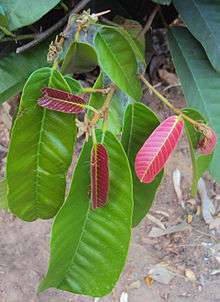Vateria indica
Vateria indica, the white dammar,[2] is a species of plant in the family Dipterocarpaceae. It is endemic to India. It is threatened by habitat loss. This tree grows like a palm but has blunt thorns along its trunk.
Vateria indica flowers
Vateria indica individual flower in detail

Saplings grown in rainy season collected

Leaves of Vateria indica
| Vateria indica | |
|---|---|
 | |
| Vateria indica illustration | |
| Scientific classification | |
| Kingdom: | Plantae |
| Clade: | Tracheophytes |
| Clade: | Angiosperms |
| Clade: | Eudicots |
| Clade: | Rosids |
| Order: | Malvales |
| Family: | Dipterocarpaceae |
| Genus: | Vateria |
| Species: | V. indica |
| Binomial name | |
| Vateria indica | |
| Synonyms | |
| |
Uses
The resin, also called white dammar, is extracted by scratching the tree's bark. It is used as incense in India, and as an Ayurvedic medicine. Vateria indica oil is produced from the seeds.
Chemical constituents
Some stilbenoids in resins from V. indica have been shown to have some in vitro anti-tumor effects in high doses when isolated from the plant.[3]
gollark: Zero pinks, actually.
gollark: WHY, RNG? I can't get a SINGLE female copper.
gollark: *continuously misses egg drops*
gollark: *really should have gotten in on it*
gollark: At this rate you'll be able to get a CB Gold for a few of them.
References
- Dhyani, A.; Barstow, M. (2020). "Vateria indica". IUCN Red List of Threatened Species. 2020. Retrieved 16 May 2020.CS1 maint: ref=harv (link)
- "Vateria indica". Natural Resources Conservation Service PLANTS Database. USDA. Retrieved 28 July 2015.
- Mishima, S; Matsumoto, K; Futamura, Y; Araki, Y; Ito, T; Tanaka, T; Iinuma, M; Nozawa, Y; Akao, Y (2003). "Antitumor effect of stilbenoids from Vateria indica against allografted sarcoma S-180 in animal model". Journal of experimental therapeutics & oncology. 3 (5): 283–88. PMID 14696625.
This article is issued from Wikipedia. The text is licensed under Creative Commons - Attribution - Sharealike. Additional terms may apply for the media files.
